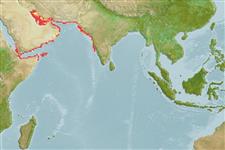>
Clupeiformes (Herrings) >
Dorosomatidae (Gizzard shads and sardinellas)
Etymology: Sardinella: Latin and Greek, sarda = sardine; name related to the island of Sardinia; diminutive (Ref. 45335).
More on author: Day.
Environment: milieu / climate zone / depth range / distribution range
Ökologie
seewasser; tiefenbereich 0 - 50 m (Ref. 188). Tropical; 30°N - 10°N, 42°E - 74°E (Ref. 188)
Western Indian Ocean: Arabian Sea, from Gulf of Aden to the Persian Gulf and Bombay.
Size / Gewicht / Alter
Maturity: Lm ? range ? - ? cm
Max length : 17.0 cm SL Männchen/unbestimmt; (Ref. 188); common length : 14.0 cm SL Männchen/unbestimmt; (Ref. 188)
Rückenflossenstacheln (insgesamt) : 0; Rückenflossenweichstrahlen (insgesamt) : 13 - 21; Afterflossenstacheln: 0; Afterflossenweichstrahlen: 12 - 23. Total number of scutes 31 to 34; lower gill rakers increasing with size of fish. Vertical striae on scales not meeting at center, only a few small perforations on hind part of scale. Closely resembles S. gibbosa which has fewer perforations on its scales. Of other sympatric Sardinella species, S. melanura has distinctive black caudal tips while S. albella has fewer scutes.
Coastal pelagic (Ref. 68964). Forms schools in coastal waters. Marketed fresh and dried-salted.
Life cycle and mating behavior
Maturities | Fortpflanzung | Spawnings | Egg(s) | Fecundities | Larven
Whitehead, P.J.P., 1985. FAO Species Catalogue. Vol. 7. Clupeoid fishes of the world (suborder Clupeoidei). An annotated and illustrated catalogue of the herrings, sardines, pilchards, sprats, shads, anchovies and wolf-herrings. FAO Fish. Synop. 125(7/1):1-303. Rome: FAO. (Ref. 188)
IUCN Rote Liste Status (Ref. 130435)
Bedrohung für Menschen
Harmless
Nutzung durch Menschen
Fischereien: weniger kommerziell
Tools
Zusatzinformationen
Download XML
Internet Quellen
Estimates based on models
Preferred temperature (Ref.
123201): 24.9 - 29.2, mean 26.9 °C (based on 172 cells).
Phylogenetic diversity index (Ref.
82804): PD
50 = 0.5000 [Uniqueness, from 0.5 = low to 2.0 = high].
Bayesian length-weight: a=0.00832 (0.00504 - 0.01373), b=3.00 (2.86 - 3.14), in cm total length, based on LWR estimates for this species & Genus-body shape (Ref.
93245).
Trophic level (Ref.
69278): 2.9 ±0.3 se; based on size and trophs of closest relatives
Widerstandsfähigkeit (Ref.
120179): hoch, Verdopplung der Population dauert weniger als 15 Monate. (Preliminary K or Fecundity.).
Fishing Vulnerability (Ref.
59153): Low vulnerability (13 of 100).
Nutrients (Ref.
124155): Calcium = 321 [173, 498] mg/100g; Iron = 2.22 [1.31, 3.98] mg/100g; Protein = 20.6 [19.6, 21.5] %; Omega3 = 0.301 [0.148, 0.587] g/100g; Selenium = 98.3 [51.3, 191.7] μg/100g; VitaminA = 25.4 [8.5, 74.7] μg/100g; Zinc = 1.32 [0.96, 1.81] mg/100g (wet weight);
